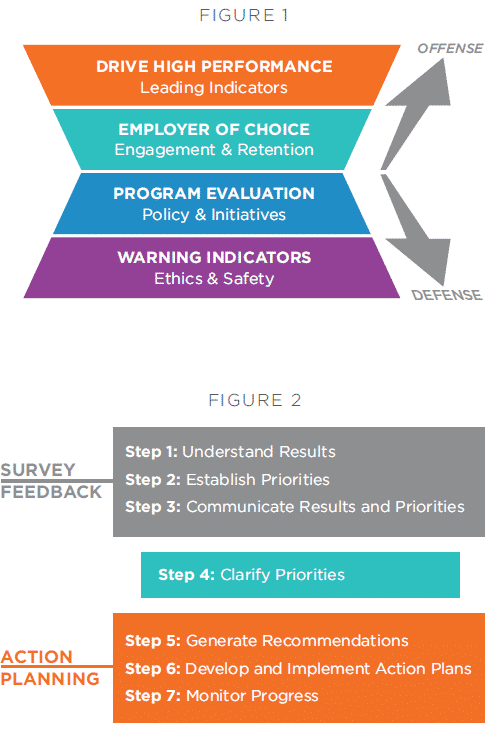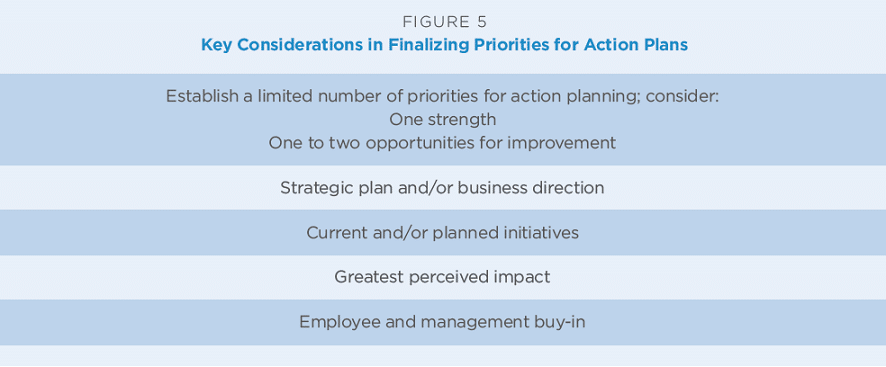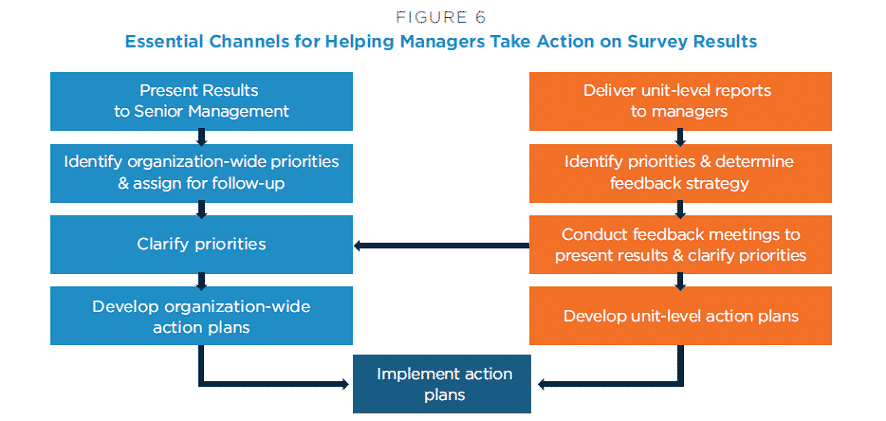Helping Managers Take Action on Survey Results

Employees with managers who take action on survey results are TWICE AS LIKELY to recommend their organization as a great place to work.
SOURCE: 2018 Trendicators Survey Report by Engage2Excel, What Do Employees Think About Engagement Surveys
INTRODUCTION
Employee surveys are used by organizations throughout the world, typically to drive change and improve engagement and retention. Giving employees a voice is seen as a ‘‘good thing to do,’’ but too often, the managerial response to the findings is ‘‘so what?’’
This publication presents a framework for HR practitioners to use in helping leadership teams and managers translate the results of employee engagement surveys into meaningful organizational change.
The ideas presented here are based on my book “Strategic Employee Surveys” (Wiley, 2010) and drawn from my extensive experience in supporting organizations in almost all major industries in most major economies around the world. Best practice advice is also provided from a survey of 31 HR practitioners who manage employee surveys within their organizations.
Typically, 20 percent of the total survey effort falls into planning, developing and administering the actual survey and reporting the results. The remaining 80 percent of the effort expended by the organization falls into the survey follow-up.
Strategically, the results are used to influence executive decision making and to create, when needed, change across the organization. At a more basic level, and in employee-centric organizations, the survey exists for no other reason than to ensure that the employee voice is heard.
Our purpose here is not to provide a step-by-step guide, but to provide organizations with a framework for how to think about survey follow-up and action planning.
Jack Wiley
Chief Scientific Officer
Engage2Excel

Jack Wiley is an author, consultant, researcher and instructor. For over three decades, he has focused on two big research questions: what employees most want and what organizational factors best promote employee engagement, performance confidence and business success.
Download
 hbspt.cta.load(123973, 'cf16003e-9bdd-4720-bb42-07f935ced581', {});
hbspt.cta.load(123973, 'cf16003e-9bdd-4720-bb42-07f935ced581', {});
OVERVIEW
Organizations generally conduct surveys for four, sometimes overlapping, reasons. These reasons exist along a continuum from “defensive” to “offensive” reasons. Starting with the most defensive reason, the four reasons are as follows:
- To identify warning signs of trouble within the organization
- To evaluate the effectiveness of specific programs, policies and initiatives
- To gauge the organization’s status or strength as an employer of choice among its workforce
- To predict and drive organizational outcomes, including customer satisfaction and business performance
Strategic Employee Survey Framework
Understanding why your organization wants to conduct an employee survey is critical to the creation of the right survey. The Strategic Employee Survey Framework (Figure 1) helps organizations understand exactly where they sit on the continuum — from “defense” to “offense.” Using this framework can significantly enhance the success of employee survey programs. A major implication of the model is that achieving a specific purpose requires survey content designed for or tailored to that strategic objective. The employee survey questions that best predict customer satisfaction and loyalty, for example, are very different from those that best predict where employees will be most susceptible to union organizing attempts.
The Seven-Step Model for Survey Feedback and Action Planning
A structured process makes it easier for organizations to manage survey follow-up, feedback and action planning. The seven-step model presented in Figure 2 was developed by Jack Wiley to help an organization know where it is starting and where it is headed. The easy-to-follow process has been used by hundreds of organizations to achieve objectives for organizational improvement. The model applies the fundamental philosophies of organizational development to employee survey methodology.

Download
 hbspt.cta.load(123973, 'cf16003e-9bdd-4720-bb42-07f935ced581', {});
hbspt.cta.load(123973, 'cf16003e-9bdd-4720-bb42-07f935ced581', {});
1. UNDERSTANDING SURVEY RESULTS
Before an organization or a manager of an individual unit can effectively communicate survey results and take action, there needs to
be an understanding of what the results reveal.
Discovering Strengths and Opportunities
The basic idea is to arrive at an understanding of the organization’s strengths and opportunities for improvement. In some cases, this understanding may come through a presentation provided by a subject matter survey expert, either internal or external to the organization. In other cases, individual managers are responsible for reviewing the result for their own department or organizational unit and drawing the proper conclusions.
Guidelines or formulas can be used to define strengths and opportunities for improvement. As shown in Figure 3, survey items with Favorable scores of 70 percent or more and Unfavorable scores of 20 percent or less are generally considered Strengths. Survey items with Favorable scores of 50 percent or less and Unfavorable scores of 20 percent or more are generally considered opportunities for improvement.
Often, normative data — in the best cases, industry or best practices normative comparisons — are available to help place survey results into context. Although normative comparisons are often viewed as highly valuable, the best point of comparison is historical survey results. Trend lines indicate whether a specific organization is making progress, standing still or declining.
Although there is no substitute for a thorough analysis of survey results, in developing an understanding of what survey results reveal, the real focus should be on the pattern of the data and the total picture they create. Organizations can waste precious time and energy when they overanalyze results and focus on organizational, normative or even trend comparisons of minor consequence.

Download
 hbspt.cta.load(123973, 'cf16003e-9bdd-4720-bb42-07f935ced581', {});
hbspt.cta.load(123973, 'cf16003e-9bdd-4720-bb42-07f935ced581', {});
2. ESTABLISHING PRIORITIES
Many organizations make the mistake of trying to work on too many priorities. This mistake is based on the myth that employees expect action on every critical issue that emerges from the survey results. They do not. What employees do expect is that their organization will respond to a few of the more important issues. At the managerial level, those issues are the priorities that managers have control over, not policy-level issues, such as the benefits the organization may offer.
One of the biggest pitfalls in effective survey follow-up processes is having too many priorities on which to work. Obviously, organizational resources are finite. Organizations whose follow-up efforts focus on a short list of priorities are usually more satisfied with the follow-up outcomes than those that have a longer nonprioritized list. Therefore, it is critical to focus on the survey-based priorities deemed to be of greatest consequence. Establishing priorities by choosing a strength to maintain and one or two opportunities to improve helps balance actions for improvement by focusing on positive and negative results.
Guidelines for establishing priorities:
- At the total organizational level, a facilitator can lead an executive team through a guided discussion aimed at establishing alignment within the group regarding the top priorities that emerge from the survey results.
- When an organization is focused on a particular index, for example, employee engagement, the organization can use statistical techniques, such as correlation, regression or even relative weights analysis, to help establish key priorities for follow-up. Identifying the correlates of a key measure illuminates the most important areas for follow-up.
- At the department- or organizational-unit level, managers can establish priorities after studying their own reports of survey results. They may also do this after reviewing and discussing the results with other managers in their unit.
- In some organizations that place a high priority on employee involvement in establishing priorities, management can create a list of four to five potential priorities and invite employees to shorten that list. Management then reviews and approves the final list of priorities.
BEST PRACTICE ADVICE: FOLLOW UP
“Keep it simple, and don’t set too many expectations. Give them a simple process to identify opportunities, and ask for one or two main objectives for the year. Also give them an outlet to roll up items that should be addressed at higher levels.”
Download
 hbspt.cta.load(123973, 'cf16003e-9bdd-4720-bb42-07f935ced581', {});
hbspt.cta.load(123973, 'cf16003e-9bdd-4720-bb42-07f935ced581', {});
3. COMMUNICATING RESULTS & PRIORITIES
Survey results should be communicated to employees as soon as practicable after the results become available. Ideally, results are presented to the leadership team of an organization, who then establish a short list of survey-based priorities for action planning.
Memo to Employees: A company-wide memo from the top leadership of the organization (preferably from the CEO) should include the following:
- Thanks for their participation in the survey process
- The survey response rate
- A short list of major strengths and opportunities for improvement
- If available, a brief reference to trend results
- Priorities the leadership team has established
- How employees will be involved in survey feedback and action planning processes
Managers receiving reports of survey results for their own organizational unit have an important communication responsibility. Providing individual managers with reports of survey results is equivalent to that manager having a responsibility to provide the feedback results to employees and involve them in developing responsive action plans.
Guidelines for conducting feedback sessions with employees:
- Employees should see the feedback and action planning process as part of how the organization normally conducts business, versus creating entirely new communication processes.
- Match the presentations of results to the audience and the appropriate level of detail. Most employees are satisfied with a summary of the overall results and more detailed information on the priorities for follow-up.
- Begin presentations of results with the positive findings and ease into discussions of negative findings with topics that are less controversial.
- Know the audience and anticipate reactions. For example, managers may need to discuss how employees view the manager’s own performance. Sensitive issues should be handled with a willingness to listen nondefensively. A defensive reaction can stifle further dialogue.
BEST PRACTICE ADVICE: EXECUTIVE SPONSORSHIP
“Senior leaders have to be the role models for survey action planning. Managers need to see that there is a benefit from making positive changes to the work environment based on survey feedback.”
Download
 hbspt.cta.load(123973, 'cf16003e-9bdd-4720-bb42-07f935ced581', {});
hbspt.cta.load(123973, 'cf16003e-9bdd-4720-bb42-07f935ced581', {});
4. CLARIFYING PRIORITIES
It is essential to involve employees in clarifying priorities by letting them tell you why they answered the survey questions the way they did. This dialogue is critical to understanding what underlies the survey results.
Figure 4 shows that survey results serve the purpose of educating and informing management regarding what employees are thinking. Involving employees in a dialogue about the survey results in feedback meetings or focus group interviews is necessary to determine why employees feel the way they do. The “what” and the “why” constitute survey feedback. Not until both sets of information are available — the quantitative survey results and the qualitative employee-based clarification of results — is the organization in a position to know how it can or should respond.
Techniques for Facilitating Dialogue: The dialogue most commonly occurs through management-led feedback sessions or focus group interviews led by a facilitator. Both techniques can be highly effective, but regardless of technique, obtaining clarification is a necessary precondition to developing on-target recommendations for improvement.
Stimulating Root Cause Discussion: The clarifying dialogue can be highly tailored to a specific set of results or be more generic. In a general sense, the types of questions that stimulate the root cause discussion deal directly with survey results and can be as simple as asking the following:
- Why do employees feel this way? What causes this attitude?
- Whom does the issue affect?
- When [or how often] does this occur?
- What’s the impact on the performance of the group?
- What are ideas or recommendations for how the issue can be addressed, fixed or improved?

Download
 hbspt.cta.load(123973, 'cf16003e-9bdd-4720-bb42-07f935ced581', {});
hbspt.cta.load(123973, 'cf16003e-9bdd-4720-bb42-07f935ced581', {});
5. GENERATING RECOMMENDATIONS
Many approaches to generating recommendations have proven successful.
This step is an important opportunity to involve employees in the process of translating survey results into meaningful business outcomes. Approaches that have proven successful include using employees to generate recommendations for improvement at the end of clarification meetings or at a later meeting, or putting together action planning teams assigned to work on a given priority.
There are occasions, based on the type of priority, when managers or management teams are the ones best suited for generating recommendations.
Decisions regarding how to tailor the process are influenced by how unit priorities may overlap or be integrated with organization-wide priorities, or the extent to which priorities align with existing strategic planning or other organization development activities.
Once recommendations have been generated, the ideas themselves must be evaluated for fit, impact and efficacy. Figure 5 presents considerations in finalizing priorities for action plans.
In evaluating potential solutions, it is important to consider how directly aligned the proposed actions are to the specific survey items or dimensions the organization hopes to improve.
A good test to apply is to ask:
“How confident am I that this action, if successfully implemented, will improve the survey results for the targeted items or dimensions the next time we survey?”

Download
 hbspt.cta.load(123973, 'cf16003e-9bdd-4720-bb42-07f935ced581', {});
hbspt.cta.load(123973, 'cf16003e-9bdd-4720-bb42-07f935ced581', {});
6. DEVELOPING & IMPLEMENTING ACTION PLANS
Once there is agreement on the best recommendations for addressing the action planning priorities, these recommendations must be converted into actions.
Specific objectives should be established that support each overall action plan.
The most successful action plans should contain objectives that are:
- Specific and easily understood
- Measurable, thus allowing progress to be monitored
- Achievable
- Compatible, that is, contributing to the mission and goals of the group but in no way working against other key objectives.
The action planning process, regardless of the techniques through which it was developed, needs to specify these components:
- STEPS: What is required to reach the objective?
- TIMING: When will it be accomplished?
- ASSISTANCE NEEDED: What resources or information are required to meet the objective?
- RESPONSIBILITY: Who will do what?
Once created, action plans will continue to require time and effort to ensure they are implemented successfully.
Guidelines for developing and implementing action plans:
- Be as specific as possible in defining the issue.
- Identify a concrete first step, that is, one that clearly reflects the transition from planning to doing.
- In some cases, it is useful to start with some easily accomplished objectives. This builds momentum for the action planning process
and trust among employees that the organization is serious about using survey results to effect change. - Ask, “What could lead this plan to fail, and how will we know when the situation is improved?” The answer to the second of those two questions is addressed in step seven.
BEST PRACTICE ADVICE: ACCOUNTABILITY
“Build accountability for action planning down to the individual manager level. Without accountability, it may not happen.”
Download
 hbspt.cta.load(123973, 'cf16003e-9bdd-4720-bb42-07f935ced581', {});
hbspt.cta.load(123973, 'cf16003e-9bdd-4720-bb42-07f935ced581', {});
7. MONITORING PROGRESS
To monitor progress, an organization must have methods of tracking and processes for reporting and discussing progress. The ultimate method for tracking progress is through the results of a subsequent survey. However, depending on your objectives, there may be other more readily available measures. For example:
- If actions are undertaken to increase employee engagement and lower voluntary turnover, then tracking voluntary turnover rates provides a measure of progress.
- If actions are undertaken to increase customer loyalty through strengthening the customer orientation culture of the organization, customer loyalty and satisfaction ratings provide highly relevant progress measures.
Processes Required: Monitoring progress also requires processes for reporting and discussing progress. Action plan progress can be reported and discussed in these ways:
- An individual performance feedback process, when individuals are responsible for implementing the action.
- Unit-level operations reviews, where progress on other key organizational initiatives and performance objectives are discussed.
- Regular meetings involving employees, such as staff or town hall meetings. Although these employee meetings may seem more like opportunities for simply reporting progress, the fact that such a report needs to be made unleashes energy useful for completing the action plan.
The final point about communication that needs to be stressed deals with the occasion when effective actions are developed and implemented but not communicated to employees.
Failure to keep employees informed about how their input is being used to change the organization can be, and often is, a
serious problem in achieving the greatest gains from organizational development.
Effective communication of action plans builds a true sense of employee involvement and participation. In organizations where this practice is implemented, employees have a much more positive feeling about the effectiveness of survey feedback as a tool for organization change, and correspondingly, leaders and managers come to realize the greatest gains from their investment in surveys, feedback and organizational development.
BEST PRACTICE ADVICE: COMMUNICATION
“Continually communicating the progress of the action plan is key. Employees may notice changes in their work environment, but they do not always tie it back to the feedback they provided on the survey.”
Download
 hbspt.cta.load(123973, 'cf16003e-9bdd-4720-bb42-07f935ced581', {});
hbspt.cta.load(123973, 'cf16003e-9bdd-4720-bb42-07f935ced581', {});
SUMMARY
The primary goal of an employee survey program is to produce tangible and lasting organizational improvements. It is easier for organizations to achieve this goal if they follow a disciplined survey follow-up process.
Every organization is unique. Survey follow-up processes should be tailored to fit the organization. If management commitment exists, if employees are involved and clarify why they feel the way they do, if employees receive communication regarding the resultant action plans and if the survey process is viewed as ongoing, then the effectiveness of survey feedback as a change strategy is virtually assured.
The results of employee engagement surveys and survey feedback are mirror images of an organization’s commitment to the process. The reflection is always clear, especially for employees. Figure 6 provides a summary of the roles of senior management and unit-level managers in translating survey results into actions that result in tangible and lasting improvement.
Guidelines for Supporting the Survey Process
- Regard the survey indexes as key business metrics
- Hold managers accountable for making improvements within their organizations
- Cascade survey results and build mechanisms for upward communication of employee issues
- Ensure an understanding of why employees feel the way they do before taking corrective action
- Identify organization-wide initiatives for driving improvement
- Promote the actions you take as a result of the survey program
- Communicate regularly how the survey process aligns with business strategy

Download
 hbspt.cta.load(123973, 'cf16003e-9bdd-4720-bb42-07f935ced581', {});
hbspt.cta.load(123973, 'cf16003e-9bdd-4720-bb42-07f935ced581', {});